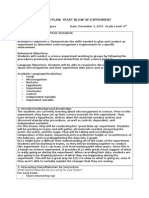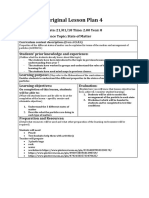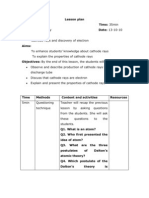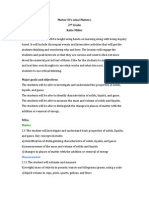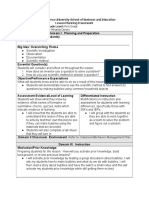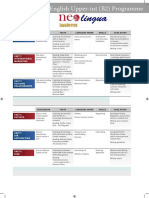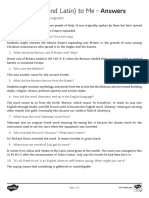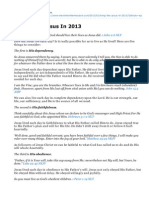Lesson 3
Lesson 3
Uploaded by
api-248372922Copyright:
Available Formats
Lesson 3
Lesson 3
Uploaded by
api-248372922Original Title
Copyright
Available Formats
Share this document
Did you find this document useful?
Is this content inappropriate?
Copyright:
Available Formats
Lesson 3
Lesson 3
Uploaded by
api-248372922Copyright:
Available Formats
KUTZTOWN UNIVERSITY ELEMENTARY EDUCATION DEPARTMENT PROFESSIONAL SEMESTER PROGRAM LESSON PLAN FORMAT
Teacher Candidate: ____________Rachael George _______________ Date: ____Feb 19, 2014________ Cooperating Teacher: __________Dawn Reiter________________________ Coop. Initials: ________________ Group Size: _______21___________ Allotted Time: __25minutes_______ Grade Level: ____1st__________ Subject or Topic: _Matter Guided Inquiry _______________ Section: _____________________
STANDARD:
3.2.1.A1: Observe and describe the properties of liquids and solids. Investigate what happens when solids are mixed with water and other liquids are mixed with water. I. Performance Objectives (Learning Outcomes) Students will be able to investigate what happens when different types of matter are added to water through the completion of this experiment. II. Instructional Materials -Vegetable oil -Square Blocks -Cup of water in clear glass -Science trays -Recording Sheet -Our rule sheets from the previous lesson -Writing utensils -Sentence starters III. Subject Matter/ Content Prerequisite skills -Ability to read and write on grade level -Knowledge of solids, liquids, and gases Key Vocabulary -No new key vocabulary is introduced in this lesson. Big Idea - Investigations help us figure out the world around us and how it works. -Matter follows the rules when introduced to different substances. IV. Implementation A. Introduction 1. Today we will be investigating how the rules we made for matter work when different items are combined together. This will help us better understand how the world around us works. At the end of this lesson, I will be collecting and checking your experiment sheets to see how you did. 2. Begin by playing a quick review game for the rules of matter we made. The rule sheets we made together will be on the front board. I will say a property students will all make a motion that matches. If it describes a solid, they will make a fist. If it describes a liquid, they will make a wave motion with one hand. If it describes a gas they will put their hand out and wiggle their fingers. 3. After the activity, I will get complete silence with the multiple pattern claps. Then I will teach
the students hands on top- everybody stop. Tell them we will be using this to go from one part of the experiment to the next. B. Development 1. Students will be paired with a table partner. Each partner will be given a tray with one of each of the above materials and two recording sheets. The materials will be discussed and explicit rules will be laid out for using the materials. 2. Together, we will go through the experiment. We will start by making a prediction. First, I will take a prediction from a student of what will happen when we put the item in and then I will model how to draw it in. Students will draw what they think the glass will look like with the item in it. On the page there is already a glass with a water line; students simply have to draw their object in. 3. Next students will be released to try it. 4. After two minutes, I will bring them back together with hands on top. 5.Then students will write what we observed that happened. I will provide a sentence starter on the board The cube.../ The oil/My breath Then I will put up the strips that have the different words and phrases the students can choose from. For the cube they will be: stayed the same shape, floated, bobbed, and sank. Students may also write their own. For the oil they will be: floated on top and made the shape of the glass. For my breath it will be: moved the water and was invisible. 5. Next, we will discuss if it followed the rules for a solid/liquid/gas while referencing back to our chart. Then students will make a check if the item followed the rules. 6. Steps 2-5 will be repeated for each material that is put in the glass. The vegetable oil will be put in last. C. Closure 1. Have a final discussion of what we saw and how it related to the rules. -Solid kept a shape of its own in the water. -The liquid matched the shape of the container and kept its space -The gas took up space and moved the water then escaped into the air around us. 2. Ask students, is there anything we may have put in the water that might have changed from the rules? Take answers and discuss ending with that We will hear about some rule breakers tomorrow!" D. Accommodations / Differentiation -Students may choose to use the sentence starters and endings, or they may work from scratch. -Students will receive modeling for each piece of the task that they will be expected to do. -Yesterday's rules will be posted for reference and to help reinforce connections throughout the lesson. -Students will be working with a partner for support with the procedures. -Irelynd, Connor, Mark, and Jayden will be checked in with frequently to ensure that they are on task. E. Assessment/Evaluation plan 1. Formative- Students' activity sheets will be collected and reviewed according to an activity rubric. The rubric will have three sections that focus on the investigation piece of this lesson. The first will deal with having made a prediction. The second will hone in on the observation piece. The last will revolve around the conclusion. These three characteristics (hypothesis, observation, and conclusion) form the core of an investigation on the properties of matter and therefore aligns with my
standard and objective. 2. Summative- There is no summative evaluation for this lesson. V. Reflective Response A. Report of Students Performance in Terms of States Objectives B. Personal Reflection 1. Did the experiment function smoothly and effectively? If not, what could I have done differently? 2. Were students engaged with the task? If they disengaged, at what point did I lose them? 3. Did I provide enough support and differentiation throughout this lesson? 4. Did this lesson fit in the time allotted? How was my pacing? VI. Resources American Chemical Society Education Devision. (2007).Inquiry in action: Investigating matter through inquiry. (3rd ed.). New York, NY: American Chemical Society. Pearson Education. (2010). Scott foresman: Science. (Grade 1 Teacher's ed., Vol. 2). Boston, Massachusetts: Pearson. Przybilla, K. (2008). Molecularium: Teacher's resource guide. Troy, New York: Rensselaer Polytechnic Institute.
You might also like
- 5e Lesson Planning Template Danielle CarpenterDocument8 pages5e Lesson Planning Template Danielle Carpenterapi-559019570No ratings yet
- Properties of Matter Introduction Lesson PlanDocument6 pagesProperties of Matter Introduction Lesson Planapi-497368912No ratings yet
- Lesson Plan 160204 Scientific MethodDocument7 pagesLesson Plan 160204 Scientific Methodapi-309206763100% (1)
- Ell Lesson PlanDocument3 pagesEll Lesson Planapi-270826504No ratings yet
- Lesson Plan Template Morgan Ewart Elephant Toothpaste FinalDocument4 pagesLesson Plan Template Morgan Ewart Elephant Toothpaste Finalapi-336127168No ratings yet
- Oracle DataGuard Physical Standby Installation Step by Step Using RMANDocument10 pagesOracle DataGuard Physical Standby Installation Step by Step Using RMANknugroho1982No ratings yet
- Matter Unit PlanDocument8 pagesMatter Unit Planapi-271760348100% (1)
- Technology Integration UnitDocument13 pagesTechnology Integration Unittegs30439No ratings yet
- Devens SciencelpDocument5 pagesDevens Sciencelpapi-282221666No ratings yet
- Developmental Lesson Plan: Standard - 3.2.3.A2Document4 pagesDevelopmental Lesson Plan: Standard - 3.2.3.A2Samantha NortonNo ratings yet
- Jessicanelson Lessonplan4 Assignment1Document6 pagesJessicanelson Lessonplan4 Assignment1api-397018670No ratings yet
- Tws 4 - 429 Channa GrihamDocument9 pagesTws 4 - 429 Channa Grihamapi-175333098No ratings yet
- Developmental Lesson PlanDocument5 pagesDevelopmental Lesson Planapi-339309940No ratings yet
- Unit Day 4Document3 pagesUnit Day 4api-653762245No ratings yet
- Lesson Plan CH 7 ReviewDocument4 pagesLesson Plan CH 7 Reviewapi-251950318No ratings yet
- Jessicanelson Lessonplan5 Assignment1Document6 pagesJessicanelson Lessonplan5 Assignment1api-397018670No ratings yet
- Science Whole Group Inquiry Lesson Plan 2Document7 pagesScience Whole Group Inquiry Lesson Plan 2api-379957585No ratings yet
- Lesson PlanDocument11 pagesLesson Plansheikh_uj3442100% (1)
- Unit Day 2Document3 pagesUnit Day 2api-653762245No ratings yet
- Unit Day 3Document3 pagesUnit Day 3api-653762245No ratings yet
- Differentiated Lesson PlanDocument5 pagesDifferentiated Lesson Planapi-273405386No ratings yet
- Science Lesson ObservationDocument4 pagesScience Lesson Observationapi-450830120No ratings yet
- Lesson Plan-Educ 1070-3 Mckenna CorinneDocument6 pagesLesson Plan-Educ 1070-3 Mckenna Corinneapi-242280098No ratings yet
- Lesson Plan (Primary)Document6 pagesLesson Plan (Primary)api-294986516No ratings yet
- Unit Day 1Document3 pagesUnit Day 1api-653762245No ratings yet
- Backward Design Lesson Plan Template: Teacher Mr. Everett Grade Level 8th Lesson Title ForceDocument4 pagesBackward Design Lesson Plan Template: Teacher Mr. Everett Grade Level 8th Lesson Title Forceapi-311722798No ratings yet
- Scavenger Hunt Lesson PlanDocument3 pagesScavenger Hunt Lesson Planapi-258318298No ratings yet
- Unit PlanDocument45 pagesUnit Plannjc72832100% (1)
- Science l4Document3 pagesScience l4api-266148783No ratings yet
- LiquidsolidgasDocument4 pagesLiquidsolidgasapi-372012287No ratings yet
- FSA Department UDL Lesson Plan FormatDocument4 pagesFSA Department UDL Lesson Plan Formatapi-623580840No ratings yet
- Lesson 1Document5 pagesLesson 1api-264643152No ratings yet
- 3 3 How Solids Liquid and Gases BehaveDocument4 pages3 3 How Solids Liquid and Gases Behaveapi-225070478100% (1)
- Assignment OneDocument45 pagesAssignment Oneapi-355627407No ratings yet
- Lesson 1 Unit MatterDocument5 pagesLesson 1 Unit Matterapi-352339425No ratings yet
- Educ424 Curriculum UnitDocument9 pagesEduc424 Curriculum Unitapi-199099982No ratings yet
- Sara HallDocument6 pagesSara Hallapi-318116860No ratings yet
- Reflective Lesson Plan-ScienceDocument12 pagesReflective Lesson Plan-Scienceapi-242013201No ratings yet
- Taylor Smith Lesson Plan 5Document3 pagesTaylor Smith Lesson Plan 5api-253118707No ratings yet
- AshleystreitmanDocument4 pagesAshleystreitmanapi-316235864No ratings yet
- Science Unit - UploadDocument17 pagesScience Unit - UploadNile YohayNo ratings yet
- Frank Science ReflectionDocument3 pagesFrank Science Reflectionapi-253865199No ratings yet
- Teach 2 RevisedDocument10 pagesTeach 2 Revisedapi-273147283No ratings yet
- Molloy College Division of Education Lesson PlanDocument4 pagesMolloy College Division of Education Lesson Planapi-311117700No ratings yet
- States of Matter Lesson PlanDocument4 pagesStates of Matter Lesson Planapi-252742039No ratings yet
- Changes in Matter Lesson 2 205 EditedDocument6 pagesChanges in Matter Lesson 2 205 Editedapi-264121817No ratings yet
- Unit Overview Ees440Document4 pagesUnit Overview Ees440api-294097634No ratings yet
- Lesson Plan OneDocument6 pagesLesson Plan Oneapi-548145330No ratings yet
- Weather and The Water Cycle Unit Plan - 1st/2nd GradeDocument19 pagesWeather and The Water Cycle Unit Plan - 1st/2nd Gradeapi-432453037No ratings yet
- Science LPDocument4 pagesScience LPapi-271280013No ratings yet
- Spe Lesson PlanDocument6 pagesSpe Lesson Planapi-437840972No ratings yet
- Mathematics and Science Sample Unit Plan Driving QuestionDocument10 pagesMathematics and Science Sample Unit Plan Driving Questionapi-197811218No ratings yet
- Educ420 Lesson 2 and 3 MatterDocument6 pagesEduc420 Lesson 2 and 3 Matterapi-199099982No ratings yet
- Bird Kaitlin Lesson PlanDocument3 pagesBird Kaitlin Lesson Planapi-317410198No ratings yet
- Integrated Art Lesson PlanDocument9 pagesIntegrated Art Lesson Planapi-253397576No ratings yet
- Lesson Plan 1 Stu TeachDocument5 pagesLesson Plan 1 Stu Teachapi-707478422No ratings yet
- WK 2 3YR OLD PLANS DAILY 2019Document33 pagesWK 2 3YR OLD PLANS DAILY 2019Long Road PrimaryNo ratings yet
- Sink or Float Science Lesson Lesson 1Document5 pagesSink or Float Science Lesson Lesson 1api-606131815No ratings yet
- Edu 223 - Lesson Plan 1Document3 pagesEdu 223 - Lesson Plan 1api-438638989No ratings yet
- Lesson Plan Permeability Model LabDocument3 pagesLesson Plan Permeability Model Labapi-251950318No ratings yet
- Elementary Science Experiments: Analyzing Data to Make PredictionsFrom EverandElementary Science Experiments: Analyzing Data to Make PredictionsNo ratings yet
- Business English Upper Intermediate ProgrammeDocument2 pagesBusiness English Upper Intermediate Programmeapi-2816679740% (1)
- Properties of Addition: Lesson 1-4Document28 pagesProperties of Addition: Lesson 1-4jamielah07No ratings yet
- Microsoft Windows XP - List of Security Vulnerabilities 2Document5 pagesMicrosoft Windows XP - List of Security Vulnerabilities 2rehmanroyalsNo ratings yet
- Style in WrittenDocument6 pagesStyle in WrittenArdi FirmansyahNo ratings yet
- LabVIEW Projects Developmentv5Document34 pagesLabVIEW Projects Developmentv5MonicaNo ratings yet
- Spiritreports Blogspot Com 2020 07 Abibu Ndjoki Kennedy HTMLDocument36 pagesSpiritreports Blogspot Com 2020 07 Abibu Ndjoki Kennedy HTMLDaniel EspinosaNo ratings yet
- Performance of Mhande Song-Dance: A Contextualized and Comparative AnalysisDocument111 pagesPerformance of Mhande Song-Dance: A Contextualized and Comparative AnalysisLwiza GannibalNo ratings yet
- Strauts Seidler HandoutsDocument18 pagesStrauts Seidler HandoutsRenusha DevendranNo ratings yet
- Detailed Lesson Plan Figures of SpeechDocument6 pagesDetailed Lesson Plan Figures of SpeechIlex Avena MasilangNo ratings yet
- 1z0 434Document38 pages1z0 434Amit AndreNo ratings yet
- Gujarat Technological University: Theory of Computation 6 SemesterDocument3 pagesGujarat Technological University: Theory of Computation 6 SemesterEr Umesh ThoriyaNo ratings yet
- Parallel PortDocument10 pagesParallel PortAnonymous hcACjq8100% (1)
- Ministers GuideDocument52 pagesMinisters Guidesheilaanyika01No ratings yet
- IntellectualBirdhouse SchwabDocument14 pagesIntellectualBirdhouse SchwabDiana RodríguezNo ratings yet
- SOL Lyrics'Document15 pagesSOL Lyrics'PaoloNo ratings yet
- Op PPT 12Document16 pagesOp PPT 12Jaymin PatelNo ratings yet
- Keil Setup For STM32F4-DiscoveryDocument3 pagesKeil Setup For STM32F4-Discoverybatrung2906No ratings yet
- FL Activity 7Document1 pageFL Activity 7Edel VillanuevaNo ratings yet
- Class-4 Files and FoldersDocument8 pagesClass-4 Files and Folderssnehapal.schoolNo ratings yet
- JavaDocument8 pagesJavamini0% (2)
- Module 1 ActivityDocument4 pagesModule 1 ActivityShaira Camille Batomalaque GabutanNo ratings yet
- شريحه 1 مصطلحات طبيةDocument37 pagesشريحه 1 مصطلحات طبيةMohamed WahidNo ratings yet
- Higher Ability AnswersDocument2 pagesHigher Ability AnswersThutra DinhNo ratings yet
- Ubuntu SSL GrSim ManualDocument16 pagesUbuntu SSL GrSim Manualyiğit_ÖksüzNo ratings yet
- Lecturer History Mcqs Past Paper 2011: Collected byDocument49 pagesLecturer History Mcqs Past Paper 2011: Collected byBilal KhanNo ratings yet
- Living Like JesusDocument2 pagesLiving Like JesusJessicaNo ratings yet
- Literature and Language TeachingDocument84 pagesLiterature and Language Teachingselcukaysegul41No ratings yet
- Includes 2356 Models 2208, 4208, 4278, 6707/8, 9808, 9208, 4209Document8 pagesIncludes 2356 Models 2208, 4208, 4278, 6707/8, 9808, 9208, 4209jotacayitoNo ratings yet
- Swetha ResumeDocument1 pageSwetha ResumeSwetha Raj VVNo ratings yet



